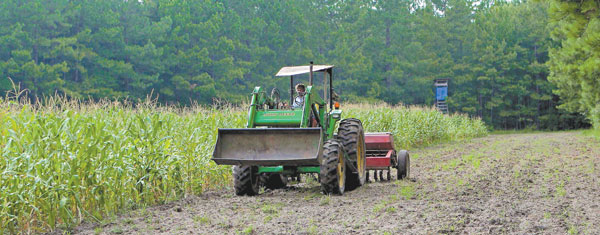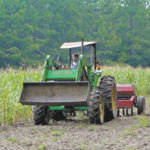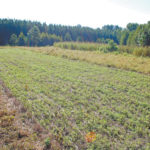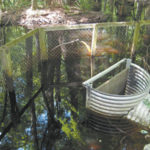
Food plots should play an important role in any wildlife-management scenario, and they should include annual and perennial sources. While nature provides wildlife with many natural foods — including soft and hard mast, grasses and tender browse located throughout the forest — these natural food sources and specific wildlife needs may not always run parallel programs. While the wildlife agencies in both Carolinas assess the deer population in each state to be relatively stable, the population of deer and other wildlife species on a local level varies from year to year.
No doubt, farmers provide deer and other wildlife species with excess available foods throughout the year. But sometimes, that soybean or corn crop will get replaced with cotton or tobacco, leaving the wildlife at the buffet table with nothing left of any value, causing these animals to fend for themselves on whatever natural food may be available at that particular time.
Forest-management activities can have positive and negative impact on wildlife, too. Despite recent depressed levels, global demand over the past two decades for softwood lumber and pulpwood remains a driving force for landowners to convert agriculture lands and forests over to pine monoculture. Pine plantations have relatively short rotations and provide landowners with a probable economic outcome. Even though clear-cut forests, thinning and older-aged pine plantations have exceptional wildlife food production, certain stages of these managed forests offer deer and other wildlife with only marginal forage availability and minimal nutrition.
Wildlife managers must take care of their own herds, providing the necessary nutrient component to keep animals healthy and local. Perennial and annual food plots provide wildlife with a steady food source throughout the year. While many natural forage and mast crops contribute to a healthy lifestyle, most natural mast sources only provide temporary groceries for the herd, and browse material really just fills in the cracks between mast-production periods. Not only does a combination of perennial and annual food plots offer deer a high source of nutrition, they are just more palatable, tasty and full of everything their bodies need.
Food plots managed with perennial and annual crops will provide wildlife with a consistent food source to be used throughout the entire year and an ideal set-up for hunting during the upcoming deer season.
Introduce alfalfa to the herd
America’s oldest perennial forage is also considered the most-important forage crop in the world.
Alfalfa is a perennial legume rarely used much in the southern wildlife scene, but it plays a vital role in many areas, providing excellent nutrition for cattle and other livestock animals. As another plant fixated on providing excess nitrogen into the soil, alfalfa can be a super food-plot crop that deer and other wildlife will just absolutely love, while receiving premium nutrition at the same time.
Alfalfa’s grazing greens provide animals with 15- to 20-percent crude protein that’s very beneficial for many metabolic processes within their systems. In addition to alfalfa’s crude protein content, elemental phosphorus (0.3 percent) and calcium levels (1 percent) are fairly substantial as well. Not only is phosphorus and calcium important to several metabolic processes throughout their systems, these two nutrients play a major role in antler development.
Alfalfa prefers well-drained sites with rich and deep, loamy-type soils. Sites with hard clays and very loose sands are not recommended. Basically, any cleared, low-lying areas with rich, brownish soils and adequate drainage will work the best. Since alfalfa is a nitrogen fixator, pre-treatment of nitrogen-rich fertilizers are not necessary, but pre-treatment of fertilizers high in potassium and phosphorus are recommended.
Alfalfa is very sensitive to acidic soil conditions. It prefers pH ranges between 6.5 and 7.0. Acidic soils should be limed appropriately 30 to 60 days before planting to raise pH to preferred levels. Alfalfa can be drilled with the small-seed attachment, no-till drilled or broadcasted across a prepared seed bed, which should be firm and can be cultipacked just before seeding. Seeds should be planted at roughly 20 to 25 pounds per acre and shallow — an eighth- to a quarter-inch below the surface. All planted seeds should be culti-packed after planting to provide a firm seed bed. If not too obviously from the last few comments, alfalfa prefers a firm seed bed.
Alfalfa should be planted during September to establish well before the year’s first frost or freeze. As a good rule of thumb, plant alfalfa 30 to 45 days before normal freezing temperatures arrive.
Even though alfalfa is a perennial plant that grows all year, seasonal maintenance is necessary to provide a highly usable stand available for consumption. But any perennial crop needs routine care to keep growing vigorously. Just as with any food plot, weeds can be a problem encroaching into the plot, and broadleaf-type weeds can be sprayed with similar herbicides used in clover patches. Pursuit, Arrow, Poast and Raptor are preferred herbicides for controlling early and late weed growth in clover and alfalfa patches. In addition to weeds, alfalfa weevils can be a problem in large production areas, but they generally will not be a problem on smaller food plots. However, if weevil predation becomes evident and begins destroying over 50 percent of the alfalfa stand, applicable insecticides should be applied, such as: Proaxis or Warrior. Consult county extension agent for more details on insecticides and application specifications.
If not already established, start growing alfalfa in some of the food plots around your property. The deer and other wildlife will quickly respond over the fall and winter months with heavy use and provide a prime hunting opportunity for the beginning of deer season.
Time to flood your duck ponds
Even thought teal season arrives this month, the majority of other winged passengers along the Atlantic Flyway are still munching on forage in Canada and the northern United States. There is no reason to flood and kill any flourishing duck foods just before the seed heads have matured. In fact, if planted on time, the corn, millets, and sorghum is just becoming mature and just about ready to get their shoes wet in September.
Even though the migrating flocks are still hundreds of miles away, mature crops with well-established seed heads should be flooded this month. Flooding essentially kills most crops within a few days and starts the decomposition process by weakening the stalks.
While ducks can eat seed heads that are within reach of the flooded water’s surface at times, few waterfowl impoundments are completely level, with the exact combination of plant height achieved and water depth. Flooding impoundments in September allows adequate time for stalks to deteriorate and collapse, depositing valuable seeds at or below the water surface, within reach of visiting waterfowl — since intentional cutting or mowing is not legal. Crops can be harvested with regular farm harvesters and flooded, but crops cannot be cut down, plowed, or mowed before flooding. This type of activity is considered baiting and not legally permissible for hunting.
Turn on the pumps, pull out the plug in gravity systems or place the boards within the flash-board risers this month to prepare flooded grain fields for migrating ducks that will be here in just a short time ahead. But keep it legal; it is never worth a ticket, heavy fines, and loss of hunting privileges.







Be the first to comment